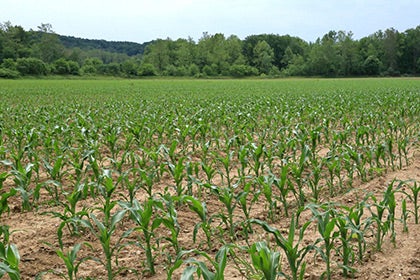
Five tips for an effective corn herbicide program
Five tips for an effective corn herbicide program
Weeds are thieves. Broadleaf weeds and grasses compete with corn for light, water and nutrients—robbing it of the inputs that growers invest in each year.
“If you don’t have good quality weed control, you won’t have anywhere close to the crop you want,” says Adam Taylor, technical agronomist with Wilbur-Ellis.
As planting season approaches, it is a useful exercise to reflect on the fundamentals of weed control to ensure your corn crop has the best start possible for maximum yields.
Taylor recommends these five tips for an effective corn herbicide program.
1. Start with a clean slate
To keep your corn weed-free throughout the duration of the growing season, it’s best to begin with clean fields. Clean fields start with a strong pre-emerge program followed with post-emerge application if needed to handle problem weeds.
“It’s important to address weeds aggressively upfront,” says Taylor. By targeting small weeds with a robust pre-emerge pass—timed as close to planting as possible—growers can help limit the negative effects of early weed competition.


SHIELDEX® and RESTRAINT™ are two strong options for your corn herbicide program. SHIELDEX is a powerful HPPD contact herbicide capable of contending with tough to kill weeds. RESTRAINT provides flexibility through timing, it is available for use in pre-plant, pre-emerge and post-emerge applications. Consult individual product labels for details.
2. Use soil adjuvants to keep herbicides in the soil profile
Soil adjuvants can keep your herbicides in the soil profile where they need to be to effectively control weed emergence for a longer time. EFFICAX® enhances control of early season weeds by increasing the coverage, absorption and adhesion of spray material deposits onto the soil particles.

“With the use of EFFICAX we have seen weed control extended from ten days to two weeks beyond what we see with that same herbicide applied at the same rate, but without EFFICAX in the tank,” says Taylor.
3. Utilize residuals to give yourself longer control

Residual herbicides help to maintain constant weed control across multiple flushes of weeds. Continuous control is important until the crop has had time to canopy and naturally outcompete weeds.
By including residual chemistry in your pre- or post-emerge passes, you provide a blanket of protection against more weed emergence.
4. Multiple modes of action – conserving for the future
Using multiple modes of action in your herbicide program helps to limit the potential for development of more herbicide resistance. This practice helps to control weeds more effectively and decisively for this season while preserving these active ingredients for the future.
“The goal of each pass is to get as many active ingredients in as we realistically can,” says Taylor. “Quite often, that is three modes of action, but it can be more.”
SHIELDEX is a Group 27 herbicide, while RESTRAINT is a premix of Group 27 and Group 15 active ingredients. By diversifying the modes of action that you apply in each pass, you can better contend with tough to manage weeds.
5. Invest in quality

A robust herbicide and adjuvant program is an investment to safeguard the yield potential and quality of your crop. Not only are you protecting the productivity of this year’s crop, but you are also managing weed pressure for the future by limiting the weed seed bank that can produce the next season’s weeds.
As you prepare for the upcoming season, it is important to remember these fundamentals to give your corn crop the best chance for success. By eliminating weed competition, the crop can reach closer to its top-end yield potential.
Trained agronomists are available to provide advice and guidance at each step. Learn more at wilburellisagribusiness.com or visit your local Wilbur-Ellis retailer for support.


